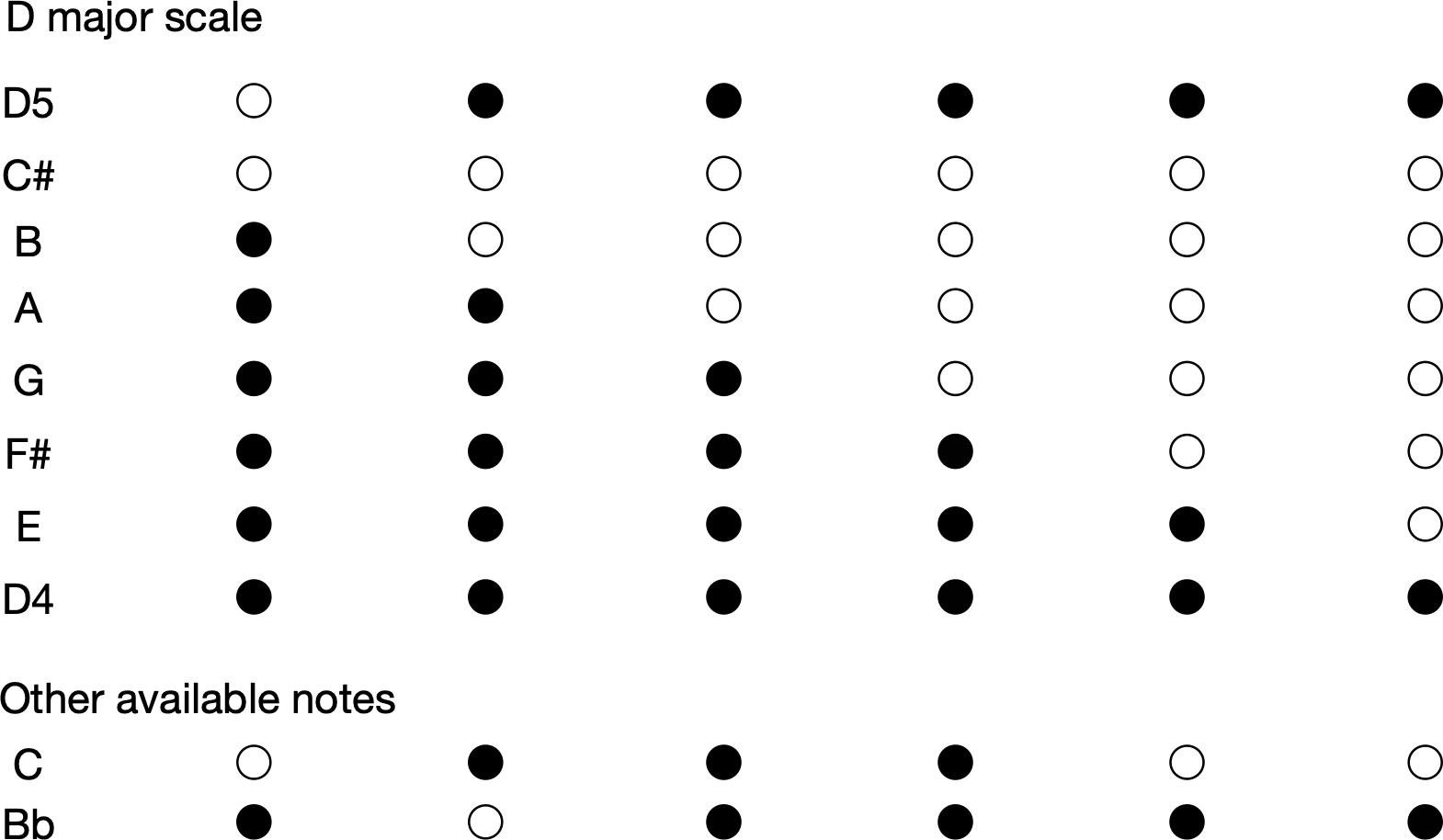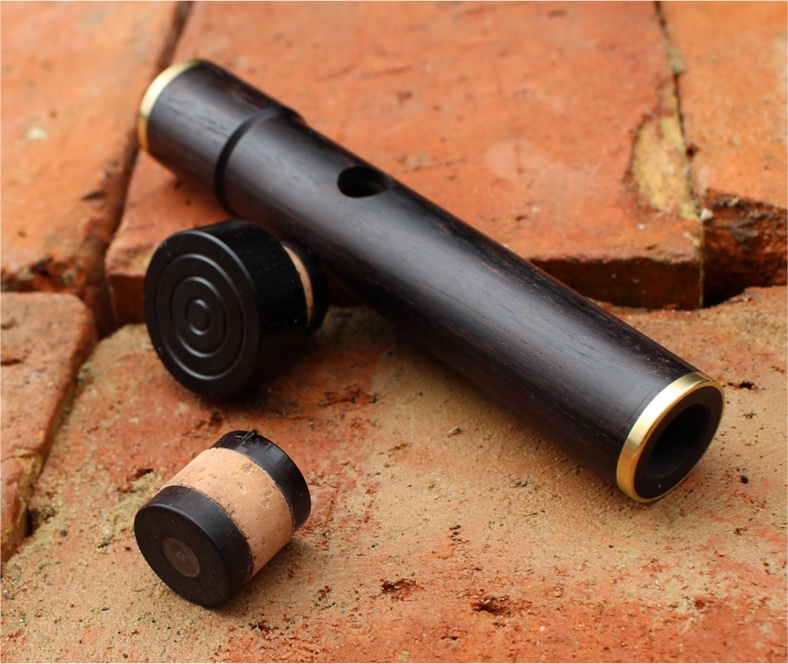Grain of rice
People think we flute players blow into our tubes in some secret magical way. Not true. We simply breathe out slowly through a tiny opening the size and shape of a grain of rice. We use our tongue to direct the jet of air to the tiny 'grain of rice' opening.
Chart
Here is a basic first octave finger chart for a Tim Adams Irish
Flute. Use the same fingering in the second octave.

Care
A wooden flute likes some care and attention. Play it often. Care
for it always.

Playing in tune
Line up the holes if you want to play in tune.(2:00s)
Maintenance
Flutes like to be played. It’s the best maintenance. That way, they get moisture, movement and air, and the music gives them some vibration in the wood, to enjoy. When they’re left lying around, the wood gets sad and squirms and twists. So ... play often!
Take it apart
When you take a break from playing (30 mins or more), get into the habit of taking the flute apart (3 parts) and laying them on the cloth case. By doing this, you allow the cork in the joints to swell and dry. If you see lots of moisture on any part of the flute, wipe it away with a cloth or absorbent paper. Never leave your flute assembled overnight.
Moisture
When you’re finished playing for the day, or for several hours, swab the flute, remove any moisture from the inside bore, the tenon joint (inside and out), and anywhere you see it. Every time you play, some moisture will gather inside the bore of
the flute. It’s good to remove it. (1:44s)
Assemble
Here are some dos and don’ts about putting the flute together. Good
to know. (51s)
Cork
If you have moved the cork for some reason, and want it back exactly
where it was when I tuned your flute, here’s how to do it. (1:45)
Grease
Especially when the flute is relatively new, grease the cork parts often (cork, end cap, tenon joints). Cork loves grease. It prevents the cork from drying and seals the flute joints.
(1:47s)
Cleaning
Twice a year, I give all five pieces of my flute a thorough and refreshing clean with a damp cloth. Then I take some warm water and soft soap and clean the cork parts. When I have dried all the parts with a clean cloth, I will re-grease the cork parts and rub the entire flute, even the ends and the inside surfaces of the holes, with Raw Linseed Oil.
Do this and your flute will look great and feel new again. It will thank you for it!
Tight tenon joint
If you notice that the tenon joint is getting too tight for comfort,
this is what you do. If you’re not happy about doing this yourself, let
me know and I’ll fix it. (2:02s)
Brass ring
If one of the rings falls off (over time, the wood may shrink and a brass ring loosens and falls off), don’t assemble the flute until you have replaced the ring. The rings prevent the wood from cracking.
Lip stain
Around the embouchure the wood gets a bit worn and discoloured after a while, due to the skin contact and all that goes with that. I usually rub it with a damp cloth, then dry it, then rub some Almond oil on that area. Dry that off too.
Annual makeover
If your flute feels a bit dry and you want to freshen it up, you can apply some oil to all the surfaces.
Music
Finally, here are some Irish traditional music resources that you might find useful.
A collection of tunes and melodies that I brought from Dublin to Sweden many years ago, along with my Andy Irvine song book. Choose a tune, at random. Surprise yourself!
Jon Antonsson passes on his knowledge and expertise. Tunes (slow and fast versions) with notation, bodhrán metronome, drones, flute exercises and inspiration.
A list of tunes that pretty much everybody knows, even me!
A huge community-supported database of tunes and melodies from Ireland!
When you want to know the name of a tune there is an app for that too – Tunepal (available for Android and iOS). Here is the Tunepal website:
Any questions or comments? Send me an email. I always answer!
Good luck with everything! Enjoy the music and magic of the wooden flute!
Tim Adams
Irish Flute Maker
Chart
Here is a basic first octave finger chart for a Tim Adams Irish Flute. Use the same fingering in the second octave.

Care
A wooden flute likes some care and attention. Play it often. Care for it always.

Playing in tune
Line up the holes if you want to play in tune.(2:00s)
Maintenance
Flutes like to be played. It’s the best maintenance. That way, they get moisture, movement and air, and the music gives them some vibration in the wood, to enjoy. When they’re left lying around, the wood gets sad and squirms and twists. So ... play often!
Take it apart
When you take a break from playing (30 mins or more), get into the habit of taking the flute apart (3 parts) and laying them on the cloth case. By doing this, you allow the cork in the joints to swell and dry. If you see lots of moisture on any part of the flute, wipe it away with a cloth or absorbent paper. Never leave your flute assembled overnight.
Moisture
When you’re finished playing for the day, or for several hours, swab the flute, remove any moisture from the inside bore, the tenon joint (inside and out), and anywhere you see it. Every time you play, some moisture will gather inside the bore of
the flute. It’s good to remove it. (1:44s)
Assemble
Here are some dos and don’ts about putting the flute together. Good
to know. (51s)
Cork
If you have moved the cork for some reason, and want it back exactly
where it was when I tuned your flute, here’s how to do it. (1:45)
Grease
Especially when the flute is relatively new, grease the cork parts often (cork, end cap, tenon joints). Cork loves grease. It prevents the cork from drying and seals the flute joints.
(1:47s)
Cleaning
Twice a year, I give all five pieces of my flute a thorough and refreshing clean with a damp cloth. Then I take some warm water and soft soap and clean the cork parts. When I have dried all the parts with a clean cloth, I will re-grease the cork parts and rub the entire flute, even the ends and the inside surfaces of the holes, with Raw Linseed Oil.
Do this and your flute will look great and feel new again. It will thank you for it!
Tight tenon joint
If you notice that the tenon joint is getting too tight for comfort,
this is what you do. If you’re not happy about doing this yourself, let
me know and I’ll fix it. (2:02s)
Brass ring
If one of the rings falls off (over time, the wood may shrink and a brass ring loosens and falls off), don’t assemble the flute until you have replaced the ring. The rings prevent the wood from cracking.
Lip stain
Around the embouchure the wood gets a bit worn and discoloured after a while, due to the skin contact and all that goes with that. I usually rub it with a damp cloth, then dry it, then rub some Almond oil on that area. Dry that off too.
Annual makeover
If your flute feels a bit dry and you want to freshen it up, you can apply some oil to all the surfaces.
Music
Finally, here are some Irish traditional music resources that you might find useful.
A collection of tunes and melodies that I brought from Dublin to Sweden many years ago, along with my Andy Irvine song book. Choose a tune, at random. Surprise yourself!
Jon Antonsson passes on his knowledge and expertise. Tunes (slow and fast versions) with notation, bodhrán metronome, drones, flute exercises and inspiration.
A list of tunes that pretty much everybody knows, even me!
A huge community-supported database of tunes and melodies from Ireland!
When you want to know the name of a tune there is an app for that too – Tunepal (available for Android and iOS). Here is the Tunepal website:
Any questions or comments? Send me an email. I always answer!
Good luck with everything! Enjoy the music and magic of the wooden flute!
Tim Adams
Irish Flute Maker
